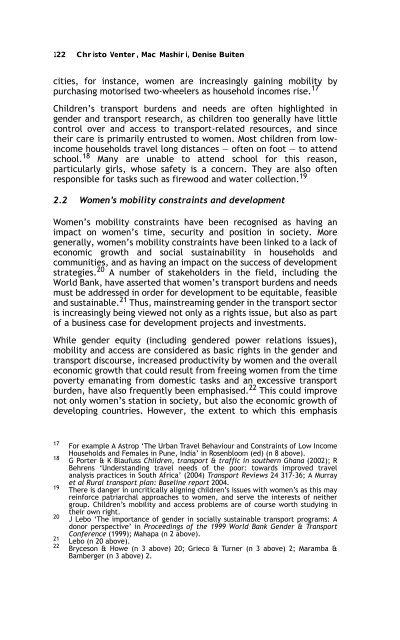Sex, Gender, Becoming - PULP
Sex, Gender, Becoming - PULP
Sex, Gender, Becoming - PULP
Create successful ePaper yourself
Turn your PDF publications into a flip-book with our unique Google optimized e-Paper software.
122 Christo Venter, Mac Mashiri, Denise Buiten<br />
cities, for instance, women are increasingly gaining mobility by<br />
purchasing motorised two-wheelers as household incomes rise. 17<br />
Children’s transport burdens and needs are often highlighted in<br />
gender and transport research, as children too generally have little<br />
control over and access to transport-related resources, and since<br />
their care is primarily entrusted to women. Most children from lowincome<br />
households travel long distances — often on foot — to attend<br />
school. 18 Many are unable to attend school for this reason,<br />
particularly girls, whose safety is a concern. They are also often<br />
responsible for tasks such as firewood and water collection. 19<br />
2.2 Women’s mobility constraints and development<br />
Women’s mobility constraints have been recognised as having an<br />
impact on women’s time, security and position in society. More<br />
generally, women’s mobility constraints have been linked to a lack of<br />
economic growth and social sustainability in households and<br />
communities, and as having an impact on the success of development<br />
strategies. 20 A number of stakeholders in the field, including the<br />
World Bank, have asserted that women’s transport burdens and needs<br />
must be addressed in order for development to be equitable, feasible<br />
and sustainable. 21 Thus, mainstreaming gender in the transport sector<br />
is increasingly being viewed not only as a rights issue, but also as part<br />
of a business case for development projects and investments.<br />
While gender equity (including gendered power relations issues),<br />
mobility and access are considered as basic rights in the gender and<br />
transport discourse, increased productivity by women and the overall<br />
economic growth that could result from freeing women from the time<br />
poverty emanating from domestic tasks and an excessive transport<br />
burden, have also frequently been emphasised. 22 This could improve<br />
not only women’s station in society, but also the economic growth of<br />
developing countries. However, the extent to which this emphasis<br />
17 For example A Astrop ‘The Urban Travel Behaviour and Constraints of Low Income<br />
Households and Females in Pune, India’ in Rosenbloom (ed) (n 8 above).<br />
18<br />
G Porter & K Blaufuss Children, transport & traffic in southern Ghana (2002); R<br />
Behrens ‘Understanding travel needs of the poor: towards improved travel<br />
analysis practices in South Africa’ (2004) Transport Reviews 24 317-36; A Murray<br />
et al Rural transport plan: Baseline report 2004.<br />
19 There is danger in uncritically aligning children’s issues with women’s as this may<br />
reinforce patriarchal approaches to women, and serve the interests of neither<br />
group. Children’s mobility and access problems are of course worth studying in<br />
their own right.<br />
20 J Lebo ‘The importance of gender in socially sustainable transport programs: A<br />
donor perspective’ in Proceedings of the 1999 World Bank <strong>Gender</strong> & Transport<br />
Conference (1999); Mahapa (n 2 above).<br />
21 Lebo (n 20 above).<br />
22<br />
Bryceson & Howe (n 3 above) 20; Grieco & Turner (n 3 above) 2; Maramba &<br />
Bamberger (n 3 above) 2.
















